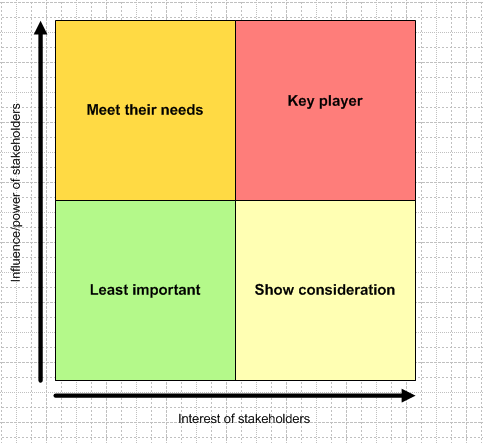There are many versions of the stakeholder matrix or quadrant. The stakeholder matrix is simple, but very effective tool for analyzing stakeholders. A graph is drawn and split into four quadrants.A common way to plot stakeholder is by power on the y axis and interest on the x axis as below:
Stakeholders are analyzed against certain critera and plotted on the graph, the completed graph enables decisions to be made based on the quadrant that a particular stakeholder falls into. stakeholdermap.com

The 6 key stakeholder matrices
Business strategists and project management experts have put forward many variations of the stakeholder matrix, the 6 most important examples are described below.Business Process Management Stakeholder Matrix
Proposed by John Jeston and Johan Nelis this matrix maps stakeholders Ability to impact the project (low to high) against their View of the project (negative to positive). Stakeholder with a high ability to impact the project, but with a negative view would be a priority for the stakeholder engagement strategy.Stakeholders with positive view of the BPM project, but a low ability to impact the project will be helpful assistants in delivering the project and evangalising the benefits. Stakeholders who are both high ability to impact and positive are the champions who the project manager would look to involve as leaders or sponsors.

Stakeholder Influence Grid
Proposed by Dragan Milosevic this matrix maps the stakeholders level of commitment against the importance of their support.High commitment and high importance stakeholders are 'fully on-board' these champions can be engaged to help drive change. Stakeholders with high commitment, but low importance are 'strong believers', those with high importance, but low commitment are 'conscientious objectors', stakeholder strategy should focus on increasing this group's commitment to the project.
Low importance and low commitmment stakeholders are known as 'cheerleaders', implying perhaps too much positivity on the part of this group.

Power and Support Stakeholder Analysis
Paul Roberts' matrix maps stakeholders by their 'Power and support'. the results help identify who is critical to a project's success. Stakeholders that fall in the top half of the matrix, high power and/or high support (Promoters), are good candidates for a project steering group. Those in the bottom half may be team members, but are unlikely to have the authority to manage the project. If a completed matrix has few people in the top half it may indicate that the project doesn't have sufficient sponsorship authority.
Power and Interest grid
Power/Interest grid, this technique from Eden and Ackermann focusses on those who have an interest in an organization or project and the power to affect the 'strategic future'.Eden and Ackermann are careful to keep the definition of power open, but the use of the term can be see as excluding stakeholders who on the face of it appear powerless, but can become powerful, if supported by a powerful advocate. Examples are direct action groups and grass roots movements that with enough publicity can significantly impact a companies strategic direction (Eden and Ackermann,198, p344).

Support and Importance stakeholder matrix
Stakeholder Assessments developed by Paul Nutt, is a grid for managing focus groups made up of stakeholders. Stakeholders are positioned on the matrix according to their expected level of support and importance to the issue.Each square on the y axis is given a 1 to 5 rating which is used to identify the 'intensity of the expected opposition or support position'. On the x axis a rating of 1 - 10 is used to measure the stakeholders importance (Nutt, 2002, p113).
Stakeholders who will likely oppose a decision or action and who are important are classed as antagonistic and are candidates for a focus group to highlight key concerns.
- x axis - Importance (least to most)
- y axis - Stakeholders' Issue Position (oppose to support)

Influence and Interest stakeholder matrix
The Influence/interest matrix suggested by the OGC in Managing Successful programme uses nine squares so stakeholders interest and influence can be measured on a scale of high, medium or low. Interest is defined as a stakeholders 'potential interest in the programme outcomes' (OGC, 2007 p53). The matrix is split into four diagonal bands:- high interest / high influence band - Key players - need strong buy-in
- low interest / medium/high influence - Active consultation
- high/medium interest / low influence - Maintain interest
- low interest / low influence band - Keep informed

Attitude and Knowledge stakeholder map
The stakeholder knowledge base, chart was developed by Rodney Turner. Stakeholders' knowledge of a project and their attitude are mapped onto a matrix. The matrix labels each box rather than using a range.Stakeholders who are aware of the project and supportive are the champions, but shouldn't be taken for granted. Supportive, but ignorant stakeholders need to be nurtured so they are not lost.
Ignorant and opposed stakeholders are a key focus area as their attitude can be changed. Opposed and aware stakeholders may never be supportive, and it is worth looking at contingency measures to manage the risks associated with these negative stakeholders (Turner, 2008, p776).

Stakeholder matrix - references and further reading
Jeston, J. and Nelis, J. (2008) Business Project Management, Butterworth-Heinemann. pgs, 271 - 276.Dragan Z. Milosevic (2003) Project Management ToolBox: Tools and Techniques for the Practicing Project Manager, John Wiley & Sons, pg. 77.
Eden, C. and Ackermann, F. (1998) Making Strategy: The Journey of Strategic Management, London: Sage Publications, pgs 343 - 347.
Turner, R (2008). Gower Handbook of Project Management, Gower. pgs, 771 - 776. Latest edition Gower Handbook of Project Management.
OGC, Managing Successful Programmes, London: TSO, 2007, pg. 51. Latest edition Managing successful programmes.
Paul C. Nutt,(2002) Why Decisions Fail: Avoiding the Blunders and Traps That Lead to Debacles, Berrett-Koehler, pgs. 113 - 114.
Stakeholder Analysis resources
FREE stakeholder analysis power/interest templateBasic Stakeholder Analysis Method
Stakeholder Analysis Pleasure and Displeasure List
Stakeholder Definition
Stakeholder mindmap
Stakeholder Salience
What is a Stakeholder?
All stakeholder map templates

